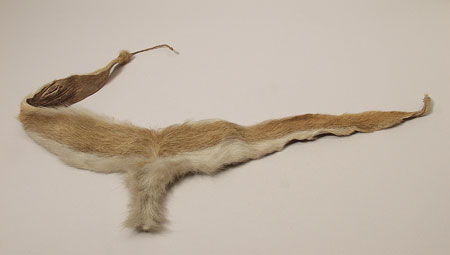Accession Number:
1934.8.21
Country:
Sudan
Region:
[Southern Sudan] ?Warab Fanamweir
Cultural Group:
Dinka
Date Made:
By 1933
Materials:
Goat Skin Animal , Plant Fibre
Process:
Twisted , Tied , Stitched , Repaired (local)
Dimensions:
L = 162 mm, W = 938 (with cord), 823 (without cord), diam cord = 2 mm [RTS 22/6/2004].
Local Name:
akak
Other Owners:
Collected by Percy Horace Gordon Powell-Cotton and his wife on 3rd May 1933 during a shooting expedition
Field Collector:
Percy Horace Gordon Powell-Cotton & Hannah Powell-Cotton (nee Brayton)
PRM Source:
Percy Horace Gordon Powell-Cotton
Acquired:
Donated 1934
Collected Date:
3rd May 1933
Description:
Belt made out of a piece of goat skin with yellowish brown hide (Pantone 7508C), covered on the reverse with caramel coloured hair in a band across the top of the belt (Pantone 7509C), and white coloured hair in strips above and below, and covering the tail flap.
There are also a few small patches of darker brown hair.
The hide has been cut to form a strip that is widest at the centre, and which tapers to either end.
A short piece of twisted plant fibre cord has been tied around one end; presumably this was then used to fasten the belt around the waist.
A thin piece of hide has been sewn through the top of the body, parallel to its upper edge, with a series of tight, oblique stitches that extends for 210 mm across the middle part of the belt.
This seems to help stiffen this area.
The body below it has been gathered up into a series of horizontal pleats, held in place by a vertical row of tight stitching, also using a thin strip of hide, knotted at intervals.
This pleating effectively pulls the top edge of the belt downwards, giving it a slight dip at this point.
A separate triangular piece of goat skin has been attached to the centre of the base below this to form the 'tail flap', with the point hanging downwards.
Four thin hide strips have been threaded vertically through this flap, using a tacking stitch, and then pulled tight, creating a series of gathers, with the top of each strip sewn to the base of the belt to hold the piece in place.
The belt is complete, but appears to have been mended, with hide stitching in two separate places that seems to be unrelated to the pleating evident elsewhere.
It has a width of 938 mm (with cord fully extended), while the skin part of the belt is 823 mm wide and 162 mm long.
The cord has a diameter of 2 mm.
Collected by Percy Horace Gordon Powell-Cotton and his wife Hannah at Fanamweir on 3rd May 1933, during a shooting expedition.
This type of belt was worn by men around the waist; its Dinka name is akak. Nebel defines this term as ‘Akak, belt with tail of cob skin’ (A. Nebel 1979, Dinka-English Dictionary, p. 16).
Rachael Sparks 24/9/2005.
Collected by Percy Horace Gordon Powell-Cotton and his wife Hannah at Fanamweir on 3rd May 1933, during a shooting expedition.
This type of belt was worn by men around the waist; its Dinka name is akak. Nebel defines this term as ‘Akak, belt with tail of cob skin’ (A. Nebel 1979, Dinka-English Dictionary, p. 16).
Rachael Sparks 24/9/2005.
Primary Documentation:
Accession Book Entry
[p.
248] 1934 [insert] 8 [end insert] -
MAJOR P.
H.
G.
POWELL-COTTON
, Quex Park, Birchington, E.
Kent.
Specimens collected by himself & Mrs Cotton, during hunting trips, 1933, viz: - From the
DINKA
tribe, FANAMWEIR & KORNUK, WHITE NILE [...] [p.
250] [insert] 21 [end insert] -
Akak
, man’s belt of hair-covered goat-skin, gathered into pleats and with tail-flap, ib[idem] [FANAMWEIR] (2022).
Card Catalogue Entry - There is no further information on the catalogue card [RTS 9/3/2004].
Related Documents File - Typewritten List of "Curios Presented to Dr. Balfour by Major & Mrs. Powell-Cotton. Dinka Tribe". This object appears as item 2022: "Man's belt with tail goat skin, pleated; native name akak , 3/5/33 Fanamweir, 8.55 N, 28.42 E". Also contains details of a cine film 'some tribes of the Southern Sudan', taken by Powell-Cotton during this 1933 expedition, copies of which are now in the National Film and Television Archive and the Powell-Cotton Museum in Kent [RTS 14/3/2005].
?Pre-PRM label - 2022 D [Card tag, tied to object; RTS 22/6/2004].
Old Pitt Rivers Museum label - Akak , man's belt with tail, of pleated goat-skin. DINKA, FANAMWEIR, WHITE NILE. 8 ° 55' N, 28 ° 42 E. d.d. Major Powell-Cotton, 1934 (2022) [tied to object; RTS 22/6/2004].
Card Catalogue Entry - There is no further information on the catalogue card [RTS 9/3/2004].
Related Documents File - Typewritten List of "Curios Presented to Dr. Balfour by Major & Mrs. Powell-Cotton. Dinka Tribe". This object appears as item 2022: "Man's belt with tail goat skin, pleated; native name akak , 3/5/33 Fanamweir, 8.55 N, 28.42 E". Also contains details of a cine film 'some tribes of the Southern Sudan', taken by Powell-Cotton during this 1933 expedition, copies of which are now in the National Film and Television Archive and the Powell-Cotton Museum in Kent [RTS 14/3/2005].
?Pre-PRM label - 2022 D [Card tag, tied to object; RTS 22/6/2004].
Old Pitt Rivers Museum label - Akak , man's belt with tail, of pleated goat-skin. DINKA, FANAMWEIR, WHITE NILE. 8 ° 55' N, 28 ° 42 E. d.d. Major Powell-Cotton, 1934 (2022) [tied to object; RTS 22/6/2004].




